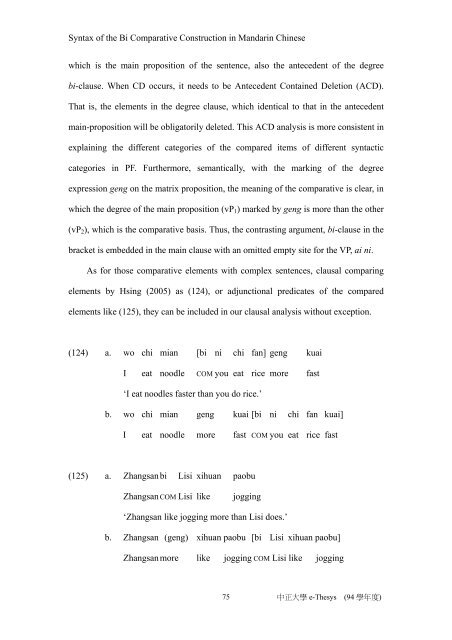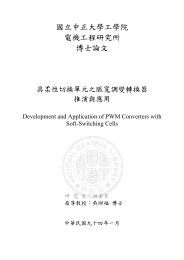Syntax of the Bi Comparative Construction in Mandarin Chinese
Syntax of the Bi Comparative Construction in Mandarin Chinese
Syntax of the Bi Comparative Construction in Mandarin Chinese
Create successful ePaper yourself
Turn your PDF publications into a flip-book with our unique Google optimized e-Paper software.
<strong>Syntax</strong> <strong>of</strong> <strong>the</strong> <strong>Bi</strong> <strong>Comparative</strong> <strong>Construction</strong> <strong>in</strong> Mandar<strong>in</strong> Ch<strong>in</strong>ese<br />
which is <strong>the</strong> ma<strong>in</strong> proposition <strong>of</strong> <strong>the</strong> sentence, also <strong>the</strong> antecedent <strong>of</strong> <strong>the</strong> degree<br />
bi-clause. When CD occurs, it needs to be Antecedent Conta<strong>in</strong>ed Deletion (ACD).<br />
That is, <strong>the</strong> elements <strong>in</strong> <strong>the</strong> degree clause, which identical to that <strong>in</strong> <strong>the</strong> antecedent<br />
ma<strong>in</strong>-proposition will be obligatorily deleted. This ACD analysis is more consistent <strong>in</strong><br />
expla<strong>in</strong><strong>in</strong>g <strong>the</strong> different categories <strong>of</strong> <strong>the</strong> compared items <strong>of</strong> different syntactic<br />
categories <strong>in</strong> PF. Fur<strong>the</strong>rmore, semantically, with <strong>the</strong> mark<strong>in</strong>g <strong>of</strong> <strong>the</strong> degree<br />
expression geng on <strong>the</strong> matrix proposition, <strong>the</strong> mean<strong>in</strong>g <strong>of</strong> <strong>the</strong> comparative is clear, <strong>in</strong><br />
which <strong>the</strong> degree <strong>of</strong> <strong>the</strong> ma<strong>in</strong> proposition (vP1) marked by geng is more than <strong>the</strong> o<strong>the</strong>r<br />
(vP2), which is <strong>the</strong> comparative basis. Thus, <strong>the</strong> contrast<strong>in</strong>g argument, bi-clause <strong>in</strong> <strong>the</strong><br />
bracket is embedded <strong>in</strong> <strong>the</strong> ma<strong>in</strong> clause with an omitted empty site for <strong>the</strong> VP, ai ni.<br />
As for those comparative elements with complex sentences, clausal compar<strong>in</strong>g<br />
elements by Hs<strong>in</strong>g (2005) as (124), or adjunctional predicates <strong>of</strong> <strong>the</strong> compared<br />
elements like (125), <strong>the</strong>y can be <strong>in</strong>cluded <strong>in</strong> our clausal analysis without exception.<br />
(124) a. wo chi mian [bi ni chi fan] geng kuai<br />
I eat noodle COM you eat rice more fast<br />
‘I eat noodles faster than you do rice.’<br />
b. wo chi mian geng kuai [bi ni chi fan kuai]<br />
I eat noodle more fast COM you eat rice fast<br />
(125) a. Zhangsan bi Lisi xihuan paobu<br />
Zhangsan COM Lisi like jogg<strong>in</strong>g<br />
‘Zhangsan like jogg<strong>in</strong>g more than Lisi does.’<br />
b. Zhangsan (geng) xihuan paobu [bi Lisi xihuan paobu]<br />
Zhangsan more like jogg<strong>in</strong>g COM Lisi like jogg<strong>in</strong>g<br />
75<br />
中正大學 e-Thesys (94 學年度)





